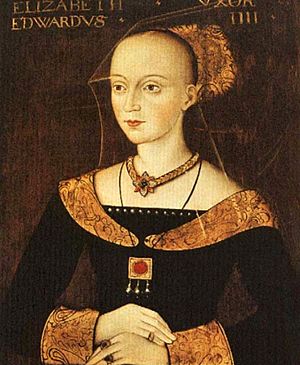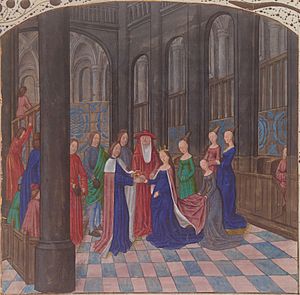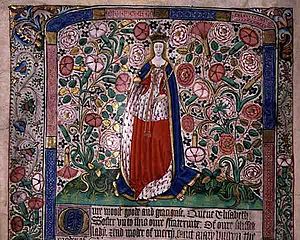Elizabeth Woodville facts for kids
Quick facts for kids Elizabeth Woodville |
|
|---|---|
 |
|
| Queen consort of England | |
| Tenures |
|
| Coronation | 26 May 1465 |
| Born | c. 1437 Grafton Regis, Northamptonshire, England |
| Died | 8 June 1492 (aged 54–55) Bermondsey, Surrey, England |
| Burial | 12 June 1492 St George's Chapel, Windsor Castle |
| Spouse |
|
| Issue Among others |
|
| Father | Richard Woodville, 1st Earl Rivers |
| Mother | Jacquetta of Luxembourg |
| Religion | Roman Catholic |
Elizabeth Woodville (born around 1437 – died 8 June 1492) was a powerful and important figure in English history. She became Queen of England when she married King Edward IV in 1464. She was queen until 1470, and then again from 1471 until Edward's death in 1483.
When Elizabeth was born, her family was not among the highest-ranking nobles. Her mother, Jacquetta of Luxembourg, was related to the royal family. Elizabeth's first husband, Sir John Grey of Groby, died fighting for the House of Lancaster. This left Elizabeth a widow with two young sons.
Her secret marriage to Edward IV caused a big stir. Elizabeth was known for her beauty. But she came from a less powerful family. Edward was the first English king since the Norman Conquest to marry someone from his own country. Elizabeth was also the first such queen to be crowned. Her marriage helped her family become very rich and powerful. But this made some important people, like Richard Neville, Earl of Warwick, very angry. This anger led to big fights between King Edward and Warwick. Eventually, Warwick changed sides and supported the Lancastrians. Elizabeth's father, Richard Woodville, was executed in 1469.
After King Edward died in 1483, Elizabeth still had political power. Her son, Edward V of England, became king for a short time. But his uncle, Richard III, took the throne. Edward V and his younger brother Richard later disappeared. Many people believe they were murdered. Elizabeth then played a key role in helping Henry VII become king in 1485.
Henry VII married Elizabeth's oldest daughter, Elizabeth of York. This marriage helped end the Wars of the Roses. It also started the Tudor dynasty. Through her daughter, Elizabeth Woodville became the grandmother of the future Henry VIII. Elizabeth's role at court later became less clear. She eventually left court and lived a quiet life.
Contents
Early Life and First Marriage
Elizabeth Woodville was born around 1437. Her exact birth date is not known. She was born at Grafton Regis, in Northamptonshire, England. She was the first child of Sir Richard Woodville and Jacquetta of Luxembourg. Their marriage caused a small scandal at the English court. The Woodvilles were a respected family, but they were not high-ranking nobles. They owned land and were wealthy. Elizabeth's mother, Jacquetta, was very important. She was the daughter of Peter I of Luxembourg. She was also the widow of the Duke of Bedford. He was the uncle of King Henry VI of England. Jacquetta was one of the highest-ranking women in England. She had promised not to remarry without the king's permission. But she married Sir Richard Woodville secretly. They were fined a lot of money when the marriage became known. But they were pardoned in October 1437. This might have been when Elizabeth was born.
Around 1452, Elizabeth Woodville married Sir John Grey of Groby. He was the heir to the Barony Ferrers of Groby. Sir John was killed in 1461 at the Second Battle of St Albans. He was fighting for the Lancastrian side. This was ironic because Elizabeth's future husband, Edward IV, was the Yorkist leader. Elizabeth Woodville had two sons with Sir John Grey. They were Thomas and Richard.
Elizabeth Woodville was known for her great beauty. People said she had "heavy-lidded eyes like those of a dragon."
Queen Consort


King Edward IV had many girlfriends. The most famous was Jane Shore. He was not known for being loyal. His marriage to Elizabeth Woodville was a secret. It is believed to have happened at her family home on May 1, 1464. Only Elizabeth's mother and two other women were there. Edward married her about three years after becoming king. He had won a big victory over the Lancastrians at the Battle of Towton. This led to King Henry VI losing his throne. Elizabeth Woodville was crowned queen on May 26, 1465.
In his early years as king, Edward IV relied on a small group of supporters. His cousin, Richard Neville, Earl of Warwick, was the most important. Around the time of Edward's secret marriage, Warwick was trying to make an alliance with France. He wanted to stop Margaret of Anjou, Henry VI's wife, from doing the same. Warwick's plan was for Edward IV to marry a French princess. When Edward's marriage to Elizabeth Woodville became public, Warwick was very upset. Elizabeth was not a noble, and her family had supported the Lancastrians. Warwick's relationship with Edward IV never fully recovered. The king's advisors were also unhappy. They told Edward that Elizabeth was "no wife for a prince such as himself."
When Elizabeth became queen, many of her relatives came to court. Some of them married into England's most important families. Three of her sisters married the sons of powerful earls. Another sister, Catherine Woodville, married the queen's 11-year-old ward, Henry Stafford, 2nd Duke of Buckingham. He later joined Edward IV's brother, Richard, Duke of Gloucester, against the Woodvilles. Elizabeth's 20-year-old brother, John, married Katherine, Duchess of Norfolk. The Duchess was in her sixties and had been widowed three times. This marriage caused a scandal at court. Elizabeth's son from her first marriage, Thomas Grey, married Cecily Bonville, 7th Baroness Harington.
Elizabeth was not from a noble family. This was the main reason for the dislike against her as queen. People often saw her as proud or disrespectful. These actions would have been normal for a queen from a higher rank. Her husband's brother, George of Clarence, even accused her of witchcraft.
In 1466, a visitor from Nuremberg, Gabriel Tetzel, came to the English court. He wrote about the luxurious life Elizabeth lived. He described her grand procession to church after her daughter's birth. She was joined by many priests, scholars, musicians, and heralds. Many ladies and knights also followed her. The queen was escorted by two dukes under a canopy. Her mother and sixty other ladies followed her. After church, they all returned to the palace. Everyone stayed to eat, filling four large rooms.
Elizabeth Woodville's relatives, especially her brother Anthony Woodville, 2nd Earl Rivers, started to challenge Warwick's power. So Warwick made a plan with George, Duke of Clarence, the king's younger brother. One of Warwick's followers accused Elizabeth Woodville's mother, Jacquetta, of witchcraft. She was found innocent the next year. Warwick and Clarence rebelled twice and then fled to France. Warwick then joined forces with the Lancastrian Queen Margaret of Anjou. He put her husband, Henry VI, back on the throne in 1470. But the next year, Edward IV returned from exile. He defeated Warwick at the Battle of Barnet. He also defeated the Lancastrians at the Battle of Tewkesbury. Henry VI was killed soon after.
When her husband lost power, Elizabeth Woodville found sanctuary in Westminster Abbey. There, she gave birth to a son, Edward. He later became King Edward V of England. Elizabeth and Edward IV had ten children in total. This included another son, Richard, Duke of York. He would later join his brother as one of the Princes in the Tower. Five of their daughters also grew up.
Elizabeth Woodville was a religious queen. She went on pilgrimages and supported Queens' College, Cambridge. She also helped found the chapel of St. Erasmus in Westminster Abbey.
Queen Dowager
King Edward IV died suddenly in April 1483. He might have died from pneumonia. Elizabeth Woodville then became the queen dowager. This means she was the widowed queen. Her young son, Edward V, became king. His uncle, Richard, Duke of Gloucester, was made his protector. He was supposed to rule until Edward V was old enough. The Woodville family tried to gain more power. But Gloucester quickly took control of the young king. He arrested the king's uncle, Earl Rivers, and his half-brother, Richard Grey. They were Elizabeth's relatives. The young king was taken to the Tower of London to wait for his coronation. Elizabeth, her younger son, and her daughters again sought sanctuary. Lord Hastings, a supporter of the late king, first agreed with Gloucester. But Gloucester then accused Hastings of plotting with Elizabeth Woodville against him. Hastings was quickly executed. We do not know if such a plot really happened. Richard accused Elizabeth of planning to "murder and utterly destroy" him.
On June 25, 1483, Gloucester had Elizabeth Woodville's son Richard Grey and brother Anthony, Earl Rivers, executed. This happened at Pontefract Castle. A law called the Titulus Regius was passed. It said that Edward IV's children with Elizabeth were not legitimate. This was because Edward IV was said to have made a promise to marry another woman, Lady Eleanor Butler, before Elizabeth. This promise was seen as a legal marriage. The law also accused Elizabeth of witchcraft. But no details were given, and the charges did not lead to anything else. Because of this law, the Duke of Gloucester was offered the throne. He became King Richard III. Edward V and his brother Richard, Duke of York, stayed in the Tower of London. No one saw them after the summer of 1483.
Elizabeth also lost all her rights as queen dowager. Her lands were given back to the Crown. Henry VII gave most of these lands back to her in March 1486.
Life Under Richard III
Elizabeth was now called Dame Elizabeth Grey. She joined forces with Duke of Buckingham and Lady Margaret Stanley. They supported Margaret's son, Henry Tudor. Henry was a distant relative of King Edward III. He was the closest male heir to the Lancastrian claim to the throne. To make his claim stronger and unite the two rival families, Elizabeth Woodville and Margaret Beaufort made a plan. Henry Tudor would marry Elizabeth's oldest daughter, Elizabeth of York. After her brothers disappeared, Elizabeth of York became the main heir of the House of York. Henry Tudor agreed to this plan. In December 1483, he publicly promised to marry her. A month before, a rebellion in his favor, led by Buckingham, had failed.
Richard III's first Parliament in January 1484 took away all the lands Elizabeth had received during Edward IV's reign. On March 1, 1484, Elizabeth and her daughters left sanctuary. Richard III had publicly promised that her daughters would not be harmed. He also promised they would not be put in the Tower of London or any other prison. He also said he would provide them with money for marriage. The family returned to court. They seemed to be friendly with Richard III. After Richard III's wife, Anne Neville, died in March 1485, rumors spread. People thought the king might marry his beautiful niece, Elizabeth of York.
Life Under Henry VII
In 1485, Henry Tudor invaded England. He defeated Richard III at the Battle of Bosworth Field. As king, Henry VII married Elizabeth of York. He also had the Titulus Regius law cancelled. All copies of it were destroyed. Elizabeth Woodville was given back her title and honors as queen dowager.
Historians have different ideas about why Queen Elizabeth spent her last five years at Bermondsey Abbey. She moved there on February 12, 1487. Some believe Henry VII forced her to leave court. Others say she had already planned to retire to a religious life at Bermondsey Abbey. Another idea is that she was forced to leave because she was involved in a rebellion in 1487. Or she was seen as someone who might help the rebels.
At Bermondsey Abbey, Elizabeth was treated with respect. She lived a royal life with a pension of £400. Henry VII also sent her small gifts. She was present at the birth of her granddaughter Margaret in November 1489. She was also there for the birth of her grandson, the future Henry VIII, in June 1491. Her daughter Queen Elizabeth visited her sometimes. But another daughter, Cecily of York, visited her more often.
Henry VII thought about marrying his mother-in-law to King James III of Scotland. This was when James III's wife died in 1486. But James was killed in battle in 1488.
Elizabeth Woodville died at Bermondsey Abbey on June 8, 1492. Her daughters attended her funeral at Windsor Castle. These were Anne, Catherine of York, and Bridget of York. Queen Elizabeth could not attend because she was expecting a child. Elizabeth's will asked for a simple ceremony. Accounts of her funeral on June 12, 1492, suggest it was not as grand as some expected for a queen. This might have been because Henry VII did not arrange a more queenly funeral. But it was Elizabeth's own wish for simplicity. A letter found in 2019 suggests she died of the plague. This would explain the quick and quiet funeral. Elizabeth was buried next to her husband King Edward IV in St George's Chapel at Windsor Castle.
Issue of Elizabeth Woodville
By Sir John Grey
- Thomas Grey (1455 – 1501). He married twice. His first wife, Anne Holland, died young. He married Cecily Bonville in 1474. They had fourteen children. Lady Jane Grey was a direct descendant of this line.
- Richard Grey (1457 – 1483). He was executed at Pontefract Castle.
By King Edward IV
- Elizabeth of York (1466 – 1503). She became Queen consort of England. She married Henry VII. She was the mother of Henry VIII.
- Mary of York (1467 – 1482). She is buried in St George's Chapel, Windsor Castle.
- Cecily of York (1469 – 1507). She was Viscountess Welles.
- Edward V of England (1470 – c. 1483). He was one of the Princes in the Tower.
- Margaret of York (1472 – 1472). She is buried in Westminster Abbey.
- Richard, Duke of York (1473 – c. 1483). He was one of the Princes in the Tower.
- Anne of York (1475 – 1511). She was Lady Howard.
- George, Duke of Bedford (1477 – 1479). He is buried in St George's Chapel, Windsor Castle.
- Catherine of York (1479 – 1527). She was Countess of Devon.
- Bridget of York (1480 – 1507). She became a nun at Dartford Priory, Kent.
Images for kids
Schools Named After Elizabeth Woodville
- Elizabeth Woodville Primary School, Groby, Leicestershire (1971).
- Elizabeth Woodville Secondary School, Roade, Northamptonshire (2011).
See Also
 In Spanish: Isabel Woodville para niños
In Spanish: Isabel Woodville para niños



